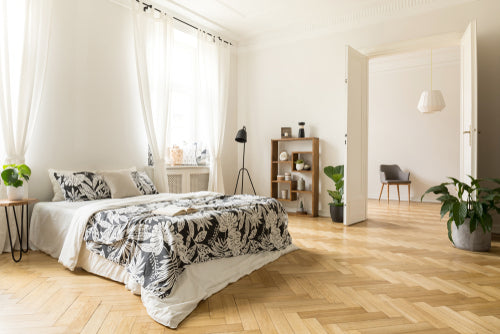
Everything To Know About Herringbone Flooring
Herringbone floor is adored by many customers for its sleek finish and ability to add dimension to any room.
With its perfect duplication of real wood at a much more affordable price, we can understand why so many homes have adopted this look.
So, what exactly is it, and why should you buy it today?
The History of Herringbone Flooring
Herringbone flooring is a distinct pattern that involves laying rectangular blocks, usually of wood, tile, or laminate, in a zigzag pattern, resembling the skeleton of a Herring fish.
The herringbone pattern has a rich history that dates back to the ancient times. It was originally used in Roman road systems. The interlocking pattern provided stability and durability until it eventually made its way into interior design.
It was coined ‘Opus Spicatum’, meaning ‘spiked work’ by the Romans. In the 16th century, it gained prominence in France, where it was used in the famous Château de Fontainebleau. Since then, it has become a staple in European architecture and design, symbolising both luxury and sophistication.
The Aesthetics of Herringbone Flooring
If you need a statement for your home, then this floor is bound to be an eye-catcher.
This intricate design adds movement and depth to any room, providing your home with character and flair. Whether you prefer a modern touch or a traditional feel, it can be paired with many interior styles.
It can also serve as a neutral backdrop for more eclectic styles!
The Benefits of Herringbone Flooring
Durability
The herringbone design creates a strong interlocking pattern that can withstand heavy foot traffic, making it ideal for busy households and commercial spaces.
Versatility
With options ranging from hardwood to ceramic tile and even luxury vinyl, there's a herringbone floor to suit every taste and budget.
This can also be used to make a room appear bigger, meaning it’s perfect for both large and smaller spaces.
Increased Property Value
The expensive look of Herringbone can add to the value of your property as it appeals to many buyers for its attractive finish. This makes it a good long-term investment.
Easy Maintenance
Many modern designs come with stain-resistant top layers that are perfect for kitchens and bathrooms.
With an easy-clean surface, this floor only requires occasional vacuuming and mopping.
Things to Consider
There are a few things you should keep in mind if you want to purchase herringbone for your floor.
Cost Considerations
This style of floor can be more expensive to purchase than other patterns due to the complexity of the design and its high-quality finish.
The cost per meter can charge anywhere between £20-£100, depending on the type of material you decide on and the size of the room.
For the fitting of the design, this can cost you a bit of money due to it typically needing professional installation. Additional costs, such as underlayment and trims, can add on £5-£10 each.
Room Size and layout
The size of the blocks and the scale of the pattern can affect how the room looks.
Larger blocks may make a small room feel cramped, while smaller blocks can make a large room feel disjointed.
Colour and Finish
If you want a room that feels light and airy, then lighter shades can create a larger sense of space in the room, creating an illusion of the room being bigger.
However, if a cosy space is what you’re looking for, darker shades can create that sense of comfort in your home.
For the overall look, a matte finish offers a more traditional look, whilst a glossy finish can make the floor more eye-catching.
Environmental Impact
Look for low-VOC or VOC-free options if air quality is a concern, and choose sustainable materials that can be recycled for future use.
How to Choose the Right Material
There are a few different types of material you can choose from that each have their own benefits:
-
Hardwood: This is durable and offers a stunning finish that can be topped up multiple times for a fresh appearance. It is the perfect fit for living and dining rooms, however, this is more of an expensive choice, and it may require professional installation.
-
Laminate: This is a cheap alternative, perfect for DIY installation. It can be added to bedrooms, offices, and hallways for a sleek look, although it isn’t as durable as Hardwood.
-
Luxury Vinyl Tile (LVT): This design is perfect for bathrooms and kitchens as it has a waterproof layer and is durable for heavy traffic areas. It is less expensive than Hardwood, however, it may not add as much value to your home.